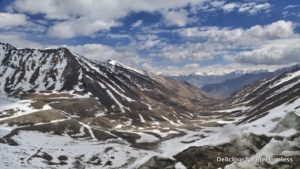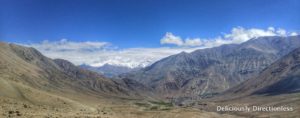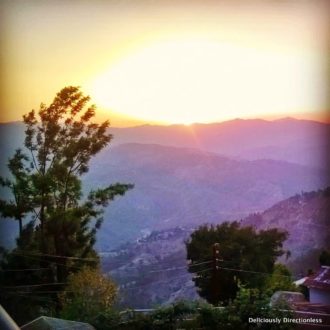Every heard of ‘glamping’? Glam camping or luxury camping is becoming more popular than ever. Safari tents and mountain camps have taken off across the world. But imagine the thrill of camping in Ladakh’s alpine beauty surrounded by the mighty Himalayas! Experience the art of glamping at TUTC Chamba Camp Ladakh.
The Ultimate Travelling Camp has two nomadic luxury camps – at Thiksey and Diskit. The husband & I got a chance to spend a week in Ladakh a couple of months ago, and we stayed at both the camps – hands down one of the best luxury stays in India!

Tent with a view
We flew from Mumbai directly to Leh. GoAir has direct flights from Mumbai while Jet Airways and Vistara fly in from Delhi, so take your pick based on your location. You can also drive up from Delhi.

Chamba Camp Thiksey is just 20 km from the airport. Our guide (Namgyal Dorje) and driver (Lobzang) picked us up from the airport and whisked us off to the camp. The drive took about 30-40 minutes.

At the reception tent, we were given a traditional Ladakhi welcome with white silk scarves.

Our valet, Sanjeev guided us to our pristine white luxury suite tent. All the tents at TUTC Chamba Camp Ladakh are triple-layered and made of weather-proof and fire-proof material. The tent was set on a wooden deck with a large patio opening out into an alfalfa field and to a mesmerising view of the Himalayas.


Inside the tent was my favourite feature – a king-size four-poster bed with memory foam mattress, a pillow menu, and cool sheets.



An elaborate chandelier hung above the bed canopy and the tent held gorgeous colonial-era furniture and vintage trunks. I loved the gleaming copper washbasin in the en-suite bathroom.

Since we had arrived on an early flight, we decided to get some breakfast before taking a nap.



The dining tent stood next to a pretty pond, and right behind the tent, Thiksey Monastery stood on a rocky outcrop. It was a clear, sunny day and we decided to have breakfast al fresco. Sitting in the crisp morning sunshine, we just couldn’t believe how lucky we were to experience this breakfast with a view.


After breakfast, we spent some time catching up on our sleep and resting in the tent to get acclimatised to the rare mountain air.
Monastery musings
We spent three days at the Thiksey Camp visiting nearby attractions. These included an evening in Leh, a jaunt up to the Shey Palace, and of course, visits to the nearby monasteries.


The camp is located practically at the foot of Thiksey Monastery. One evening we walked up to the monastery where we shared a thukpa and butter tea dinner with the monks. Read all about our delightful dinner in my article for The Hindu Sunday Magazine.


Another day, we drove 15 km across the Indus River to the Matho Monastery. Here a team of art restorers and locals is working hard to preserve Ladakh’s history and culture in a dedicated museum. The Matho Monastery Museum (MaMoMu) is slated to open in the summer of 2018. Read more about it here.


We were in Ladakh in early July and luckily our visit coincided with the Hemis Festival at the Hemis Monastery, a 25-km-drive from the camp. The folks at TUTC Chamba Camp Ladakh had kindly arranged VIP seats for us. From the viewing gallery, we had an excellent vantage point to watch the colourful and musical performances of the monks.

In the valley
After spending three relaxed days at the Thiksey camp we left for Chamba Camp Diskit in the Nubra Valley.


We woke up bright and early to avoid the ‘traffic jam’ at Khardung-La, the highest motorable road in the world. The view from the top was a stunning vista of chocolate mountains streaked with vanilla snow.



We arrived at Diskit camp a bit tired but excited about discovering a different part of Ladakh. Done up in earthy brown and orange tones, the Diskit camp has a more rustic feel compared to the Thiksey camp. All the tents in the camp faced the Diskit monastery perched dramatically in a gorge of a snow-capped mountain.
After a brief rest, we drove to the Hunder Desert, just 10 minutes from the camp.


It’s quite a surreal sight – huge sand dunes stretched as far as we could see, and soaring, snow-capped Himalayas on all sides. We rode Bactrian (two-humped) camels and later ambled about the sand dunes till dusk fell.

We spent a couple of days in Nubra valley, visiting the Diskit monastery, driving to nearby villages and experiencing local food before returning to the Thiksey camp.


Instead of returning via Khardung-La, we took the Wari-La pass, which is as scenic but not used by many people. We must have passed about 8-10 vehicles on our 5-hour journey, mostly locals and army personnel.

A word about the food – the chef and his team at both the camps served us delicious multi-course meals throughout our stay. We had options of both Indian and Western meals. We also tried a few local dishes like thukpa and momos.
When to go to Ladakh
TUTC Chamba Camp Ladakh sets up base during the summer months, usually between May and October every year. Check their website for the exact dates.
TUTC also has a camp in Kohima, which coincides with the Hornbill Festival, another bucket-list item for me! If you plan to go this year, check out the dates and booking information on TUTC.

Have you gone glamping? How was your experience? Leave us a comment below.
This feature was commissioned by New Indian Express – Indulge Magazine and was published in their issue dated September 22, 2017. Read it here.


